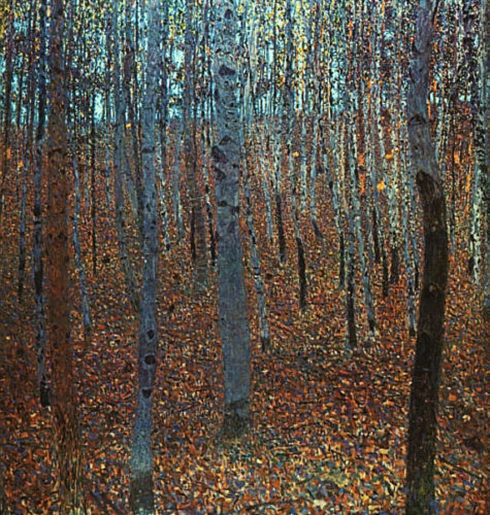Syd Barrett’s keen eye introduced me to Klimt’s painting ‘Beechwood Forest‘, thereby introducing me to Klimt’s landscapes; magical worlds where trees become femme fatales, sensual creatures of nature.
Gustav Klimt is best known for his sensual and sinister femme fatales, but at the same time he enjoyed painting landscapes, which were usually created in moments of contemplation, peace and relaxation. Although he had been drawing numerous sketches for his portraits and allegorical scenes before painting them on canvas, Klimt painted nature while residing in it, painting flowers and trees without previous sketches, portraying nature in the most natural way.
Klimt found peace in painting landscapes, the same way Renoir had found it earlier, painting flowers with colours that were left after painting portraits. From 1897. Klimt had been spending his summer days in Litzlberg at Lake Attersee, enjoying the warm, sunny days with his life companion Emilie Flöge. He was known for starting his holiday days early, around 6 o’clock, with long strolls in the woods which prompted locals to call him ‘Waldschrat‘; someone who lives in the woods on his own. I can’t resist adding a few verses from Syd Barrett’s song ‘Octopus’; ‘Isn’t it good to be lost in the wood/Isn’t it bad so quiet there, in the wood.‘ Gustav Klimt undoubtedly drew inspiration from these long walks, connecting his soul to nature, breathing the fresh air. I wonder are the trees that he touched still there?
Beechwood Forest (Buchenwald, 1902) is one of my favourite landscape paintings by Klimt, along with The Swamp (1900). These two paintings are significant as one of the earliest examples of Klimt’s landscapes, daringly combining styles of Impressionism and Symbolism. Brush strokes evoke the painting style typical for Impressionism, while the simplified and symbolic treatment of surface, along with the influence of the Orient, make these paintings typical for Art Nouveau. Still, Gustav Klimt was never interested in the game of light and shadow, his landscapes, the same as his portraits, display his interest in allegories. The Swamp was painted on the shore of one of the ice ponds near Litzlberg. Paintings such as ‘Beechwood Forest‘ or ‘The Swamp‘ resemble a tapestry, filled with patterns that could easily be found on a dress of one of his femme fatales. Sensible trembling of his landscapes enhances their ornamentation and symbolic meaning. In ‘Beechwood Forest‘ dense beech trees blot the sky, and each leaf is captured in one golden brush stroke; such paintings were appealing to Syd’s Cantabrigian sensibilities.
Klimt approached painting landscapes the same way he painted women, with visible sensuality and liveliness. The absence of people in all of his landscapes suggest that Klimt perceived the landscape as a living being, mystical pantheism was always prevalent. The nature, in all its greenness, freshness and mystery, was a beautiful woman for Klimt.





Very well written I must say, ‘Beechwood Forest’ is a wonderful painting, the Birch trees look so real yet also dream-like, one feels that one could just walk into it and feel the golden leaves crackle underfoot and touch the papery bark. the colours in it are exquisite.
LikeLike
I utterly agree with you!
What a poetic thing to say, there’s no doubt that you love nature! 🙂
LikeLiked by 1 person